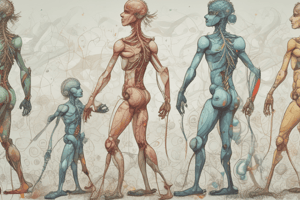Podcast
Questions and Answers
What is the main assumption made when modeling changes in allele frequency in a very large population?
What is the main assumption made when modeling changes in allele frequency in a very large population?
That the population has a very large number of individuals and therefore randomness does not matter.
What is the result of stochasticity in a small population?
What is the result of stochasticity in a small population?
Random deviations in contributions between genotypes, leading to changes in allele frequency.
What is the term for stochastic changes in allele frequencies?
What is the term for stochastic changes in allele frequencies?
Genetic drift.
Why do neutral alleles change in frequency over time?
Why do neutral alleles change in frequency over time?
What is the result of modeling a neutral allele in a population with a single self-fertilizing individual?
What is the result of modeling a neutral allele in a population with a single self-fertilizing individual?
What are some other stochastic measures in evolutionary genetics besides genetic drift?
What are some other stochastic measures in evolutionary genetics besides genetic drift?
What is the eventual outcome of genetic diversity in a population when the offspring are produced by random sampling of gametes from the parents?
What is the eventual outcome of genetic diversity in a population when the offspring are produced by random sampling of gametes from the parents?
Under what conditions can genetic drift, resulting in the loss of genetic diversity, occur even in a large population?
Under what conditions can genetic drift, resulting in the loss of genetic diversity, occur even in a large population?
What was the outcome of the experiment using Drosophila melanogaster in 1956?
What was the outcome of the experiment using Drosophila melanogaster in 1956?
How does the size of the population affect the rate of genetic drift?
How does the size of the population affect the rate of genetic drift?
What is the ideal condition for studying genetic drift in a population?
What is the ideal condition for studying genetic drift in a population?
What is the significance of the experiment using Drosophila melanogaster in 1956?
What is the significance of the experiment using Drosophila melanogaster in 1956?




